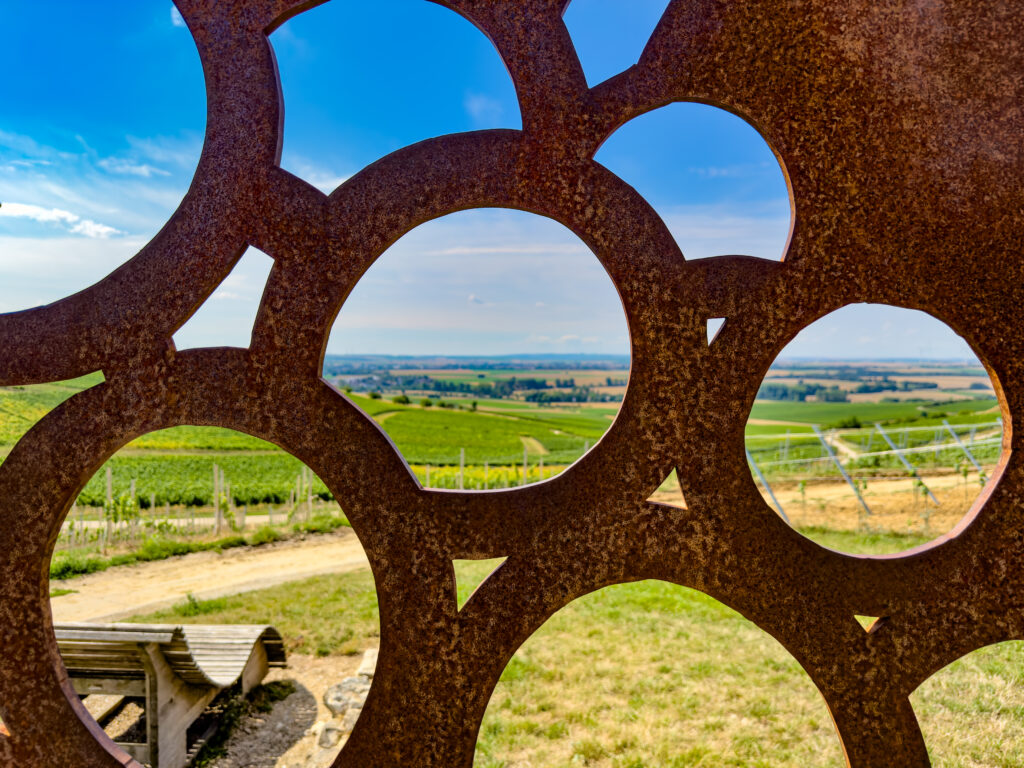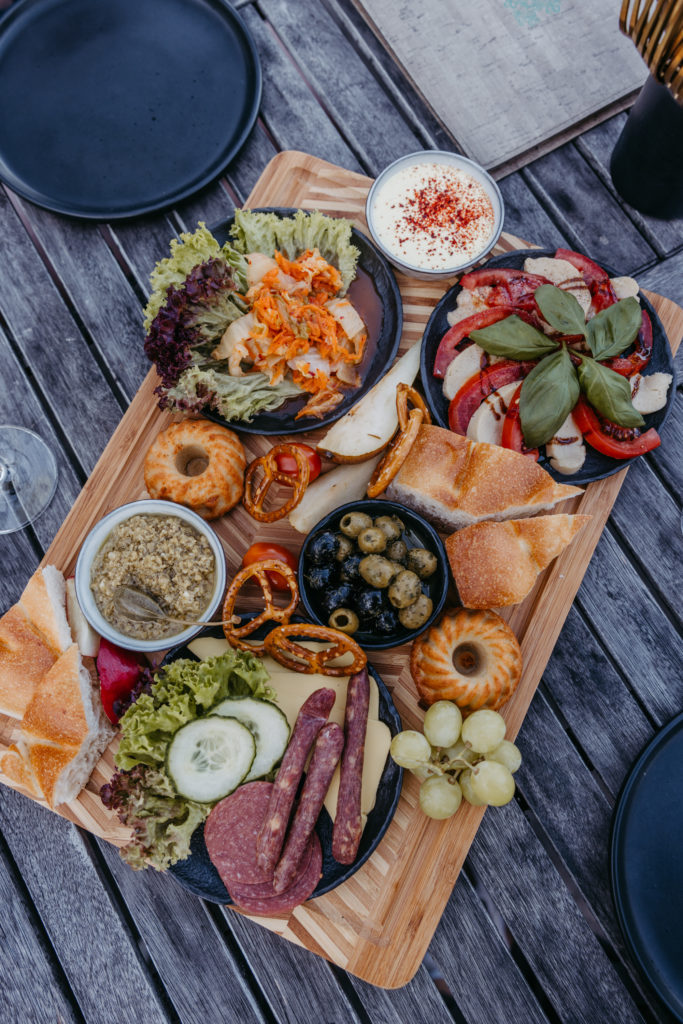The importance of terroir
The word terroir is French, but cannot be translated directly. In relation to viticulture, the term terroir encompasses the natural and human factors of influence - and their interplay - on the cultivation and taste of wine. And these factors are manifold:
The Location of the vineyard, including height and slope shape, plays with the nature of the Ground together. In addition comes the Climate in the form of sunshine hours, precipitation and temperature. The Region itself, its history, culture and traditions also play an important role. And last but not least, in all of this, the Winemaker with his philosophy, his work in the vineyard and his flair in the cellar in the center.
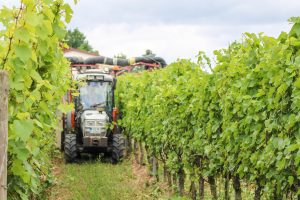
So you see, terroir is not so easy to explain. But one small aspect of it - the geological aspect - can be seen on the roadside of the Hiwweltour Stadecker Warte experience actively and on the basis of soil profiles.
Welcome to the vineyard
The local winegrowers in Stadecken-Elsheim lovingly take care of the Prädikat circular hiking trail. They have built many of the rest areas along the route themselves and take care of the mowing and mulching of the hiking trails.
But the winegrowers do not only care about the "experience hiking", they also want to bring you closer to the "experience wine". At the Hiwweltour two soil profiles are exposed, which illustrate the geological aspect of the terroir. You can look at the soil structure, touch it and take the respective characteristics from the corresponding information boards.
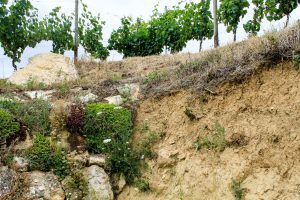
Quality instead of quantity
The sand-lime floor profile of the Stadecker Lenchen lies directly below the table of the wine. If you take some sand in your hand here and hold it in the sun (which is hopefully shining), you can not only see different grains, but also the typical glitter.

For the roots of the vines there is plenty of space and air between the fine sandy soil particles. This causes a good warming of the soil and thus good ripening possibilities for lively wines characterized by a fresh acidity. The sandy soil can also hardly bind water. Therefore, a dense root network forms in the upper part of the soil to absorb rainwater there. Further down, dryness prevails and this causes a reduction in yield, which in turn ensures an increase in quality.
Hard life for the vines
Once you have passed the Stadecker Warte, a little later you can take a short break under the pergola built by winegrowers themselves. Right next to it is the clay marl soil profile of the Stadecker Spitzberg. If the soil is dry, the typical cracks appear in the profile; the clay marl then becomes as hard as stone. If the ground is moist, however, you can feel that the clay marl is as soft as plasticine. And on your shoes you will carry home a nice memory.
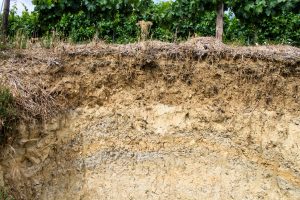
The vine does not have it easy in this soil. If the clay marl swells when it rains, the fine roots are crushed and there is a lack of air. In addition, some of the water bound in the clay does not reach the vines at all. Therefore, winegrowers often loosen the clay marl soil and add humus or loess to it. These difficult conditions, however, produce interesting and full-bodied wines that are characterized by minerality and complexity. So the painstaking work is worth it!
Visit to the winemaker
After you have learned a lot about terroir and wine on the Hiwweltour Stadecker Warte, a subsequent visit to the local winegrowers in Stadecken-Elsheim is just the thing.
At the Eppelmann Winery you can not only taste excellent wines, in the "Rheinhessen EXCELLENT" PanoramaVinothek you have meanwhile also a fantastic view of the surrounding vineyards. During opening hours you are always welcome and can simply come to the farm. In addition, the family farm invites you to numerous events with special wine tasting experiences.
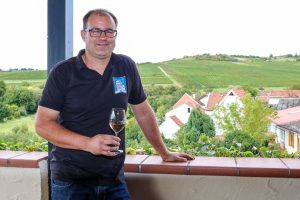
Timo Eppelmann takes care of the cultivation and care of the vines and accompanies the grapes to the winery. In his function as cellar master, he conscientiously ensures the gentle refinement of the grape into wine and is thus himself an important terroir influencer. He is also the chairman of the local farmers' and winegrowers' association and thus jointly responsible for the design and maintenance of the Prädikat hiking trail.
Hiwweltour personally
For Timo Eppelmann, hiking in Rheinhessen is pure enjoyment. Beautiful and, above all, environmentally compatible hiking trails that do not disadvantage surrounding farmers ("Consideration makes trails wider!") are indispensable - and he sees this wonderfully implemented on the Hiwweltour Stadecker Warte.
The terroir soil profiles are also very special to him, but his favorite spot on the Hiwweltour is the large pavilion in the Wingert, from which you have a magnificent panoramic view of the Rheinhessen cultural landscape. Here, he reveals, you can see very clearly why the Hiwweltour bears this name ("Hiwwel" is Rhinehessian for "hill").
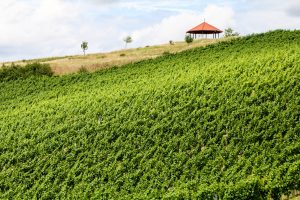
The Hiwweltour Stadecker Warte combines nature-oriented hiking with descriptive knowledge about terroir, which significantly determines the taste of wine. So you will also learn what characterizes the wine along the Hiwweltour. And when you taste it after your hike at the local winegrowers in Stadecken-Elsheim, you will be able to talk about it in a completely different way!



